Throughout the past year, we’ve seen a mix of neighborhoods becoming more expensive while others have developed more stabilized rents for its tenants. Finding affordable apartments in NYC is a difficult and daunting task. That’s why we here at RentHop dived into street boundaries to determine if there were any price changes when it comes to renting 1-bedroom building apartments across different street boundaries in NYC.
Key findings:
- On average, renters can save more from renting non-walkup building apartments across East 96th Street, West 72nd Street, Houston Street and Lower 3rd Avenue as compared to walk-up building apartments.
- Non-walkup and walk-up building apartments exhibit contrasting pricing behaviors across street boundaries such as East 14th Street and Houston Street. On the north of East 14th Street and Houston Street, non-walkup building apartments are more affordable whereas, on the south of the streets, walk-up building apartments are found to be more affordable.
- Our analysis reveals that the most significant price savings of $1,350 and $381.25 from renting non-walkup and walk-up building apartments are roughly 2 blocks north (160 m) from East 96th St respectively.
- Across Lower 3rd Avenue, prices decline gradually from the west to east side of the boundary. For non-walkup building apartments, a major price saving of $995 per block is observed moving towards the east side of the boundary.
- In Brooklyn, those living around the Broadway boundary could save up to $300 by moving to a walk-up apartment 3 blocks west of Broadway.
- Residents of Queens can save about $250 by moving to a walk-up apartment 160 m to 320 m south of 36th Avenue.
Navigation: East 96th St | West 72nd St | East 73rd St | West 125th St | East 14th St | Houston St | Lower 3rd Av | Metropolitan Av | Classon Av | Broadway | Parkside Av | 36th Av
The visuals below plot median prices of 1-bedroom apartments as a function of distance to each street and avenue in the uptown, midtown, and downtown regions of Manhattan. We also define non-walkup building apartments as buildings with either elevators or a doorman. The median price differences reflect how much the rental prices drop across each of the boundaries. For further clarity, we approximate each block of a street to be roughly 80 meters.
Manhattan
Price savings across E 96th St: Median prices of non-walkup and walk-up building apartments drop sharply 160 m (2 blocks) north of E 96th St by about $1,350 and $381.25 respectively.
Neighborhoods: East Harlem (North), Carnegie Hill, UES, Yorkville (South)
Median prices of 1-bedroom apartments in East Harlem are generally lower than other neighborhoods to its south. While it holds true, we discover that 1-bedroom median apartment prices continue to rise north of E 96th St before dropping after a few blocks.
To better understand the effects of distance from the street boundary on the median price of different types of apartments, we first break down the apartment types into 2 categories – non-walkup and walk-up building apartments before plotting the median prices of 1-bedroom apartments for each category as a function of distance from E 96th St.
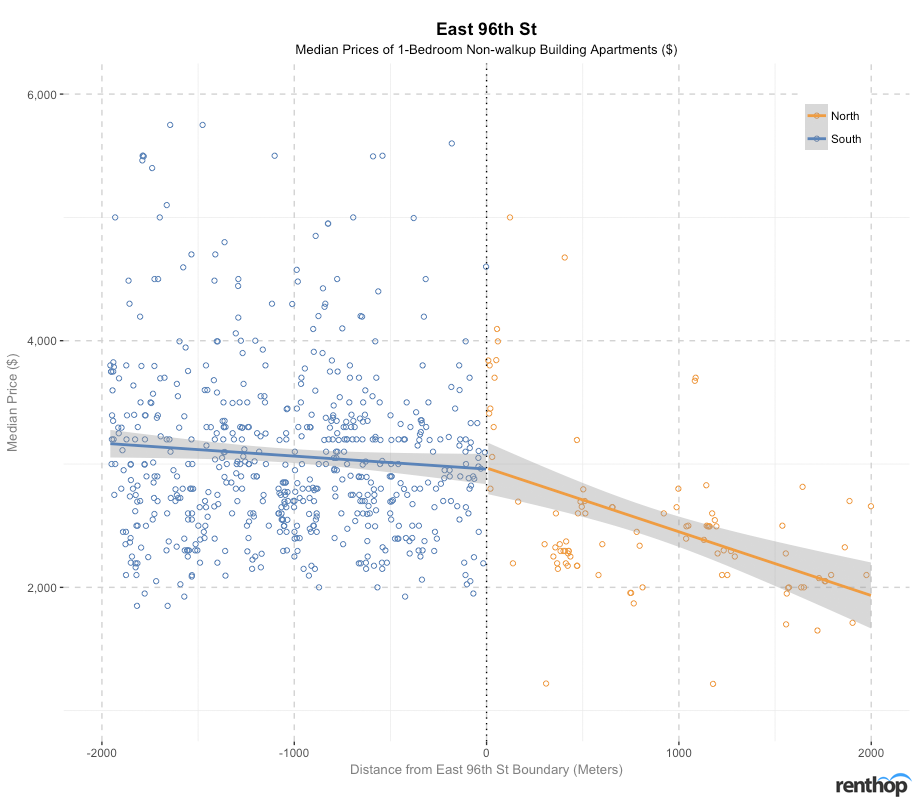
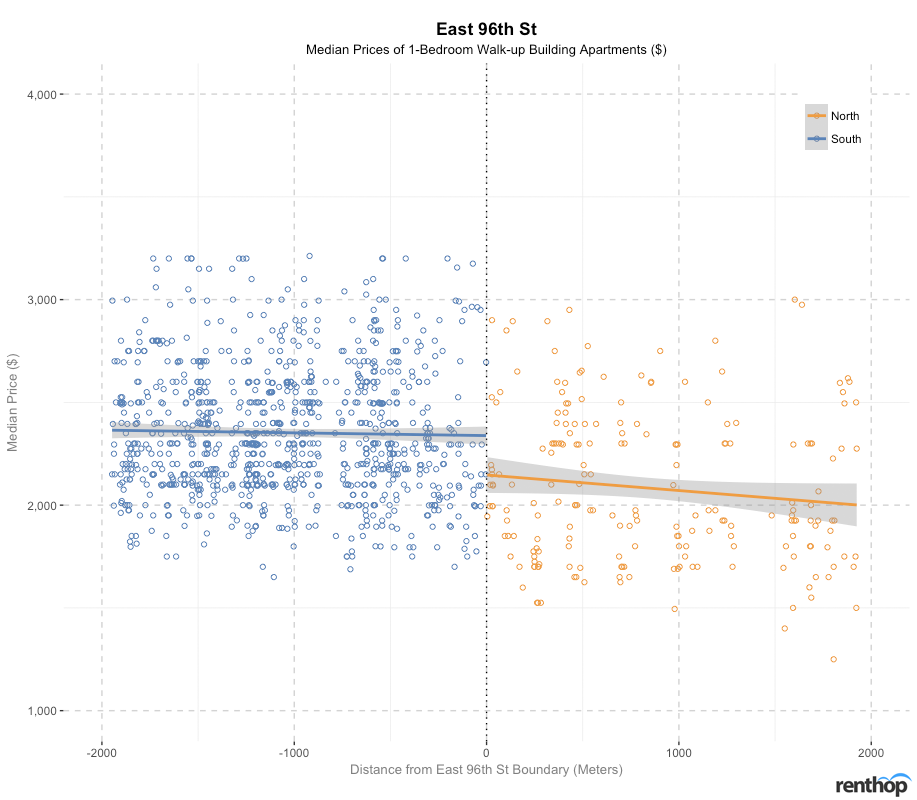
Although median prices of 1-bedroom apartments are generally lower on the north of E 96th St, non-walkup building apartments are more expensive at E 96th St and north of E 96th St. For walk-up building apartments, median prices are slightly more affordable north of E 96th St, with 8.5%-15.3% difference between the north and south E 96th boundary. This leads us to question if the real East Harlem demarcation line has shifted towards the north?
After a closer look at 1-bedroom median prices north and south of E 96th St, we can confirm our hypothesis – median prices of both non-walkup and walk-up building apartments drop most drastically north of E 96th to around 160 m. The median price of non-walkup building apartments declines significantly by $1,350 from $3,700 to $2,350 while the median price of walk-up building apartments declines by a smaller margin of $381.25 from $2,100 to $1,718.75. Thereafter, the median price of both types of building apartments remain relatively stable.

The likely reason of the rise of non-walkup building apartments north of E 96th St could be attributed to the advancements in gentrification in the East Harlem neighborhood since the 1980s, particularly along the second and third avenues. In 2005, East Harlem released a new wave of luxury condos and Co-Ops along the 1st avenue from 96th St. In the more recent news, on 30 October 2017, the East Harlem Rezoning Proposal was approved by the NYC City Council, with focus on developing the area. With the development of these new residential buildings and public housing projects comes hefty rental price tags on the apartments. This process of gentrification rapidly changes the neighborhood and spurs growth in prices.
Beyond gentrification, the opening of the 2nd Avenue subway station has further increased the convenience and accessibility to get to East Harlem by Q Broadway Express trains, which further increased the housing value within the area. In 2016, East Harlem was also featured in New York Times as one of New York’s next hot neighborhoods, with emphasis on more affordable luxury housing as compared to a couple of blocks down in Upper East Side, where costs are about 8.5%-22.2% higher.
And with all that, it is no wonder that the East Harlem demarcation line is now softer and more blurred. Also, if you’re a renter on a budget, you could reap a significant price-differential of 36.5% by choosing to rent a non-walkup building apartment 2 blocks of streets north of E 96th St.
Price savings across W 72nd St: A small fall of about $195 for non-walkup building apartments 160 m (2 blocks) north of W 72nd St. Prices continue to fall 320 m north of the street before increasing.
Neighborhoods: Upper West Side (North), Lincoln Square (South)
Neighborhood-wise, 1-bedroom apartment prices south of W 72nd St (Lincoln Square) are higher than north of W 72nd St (UWS). While UWS has always been known to be a wealthy, upscale neighborhood, Lincoln Square now emerges with higher rent prices than UWS.
Lincoln Square is a neighborhood with numerous great schools and cultural amenities. It doesn’t come as a surprise to us that Lincoln Square is highly demanded, with its rental prices being relatively higher than UWS. Situated at the southern tip of UWS, Lincoln Square is also near the city center, which makes it central and accessible to many locations, including Central Park and Columbus Circle. The commute time to the city center is also shorter. Moreover, the neighborhood is also overflowing with great restaurants, art galleries, parks, cafes and other neighborhood amenities, which adds value to the location.
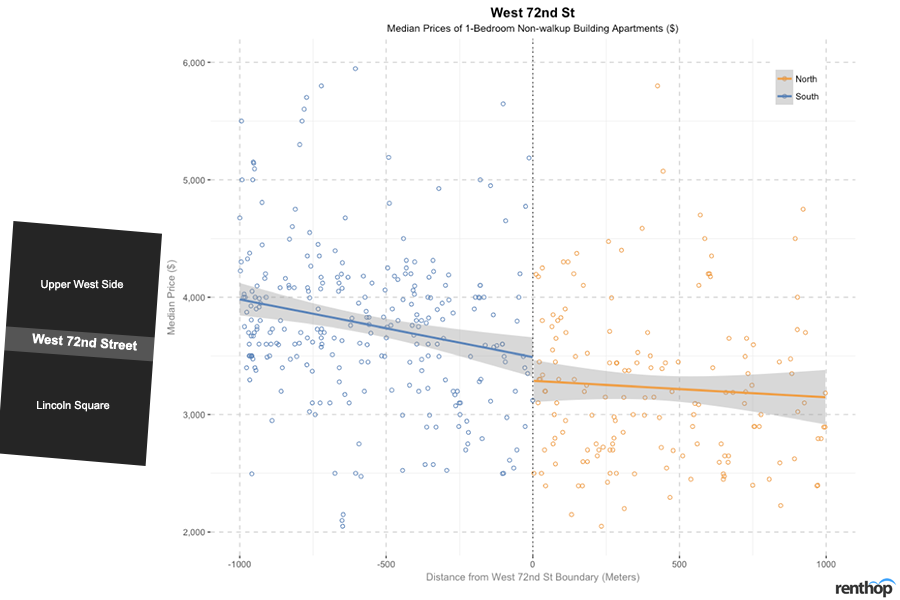
Across the 25th to 75th percentiles, non-walkup building apartments are 11.9%-16.7% more expensive south of W 72nd St while walk-up building apartments are 3.7% more expensive north of W 72nd St.
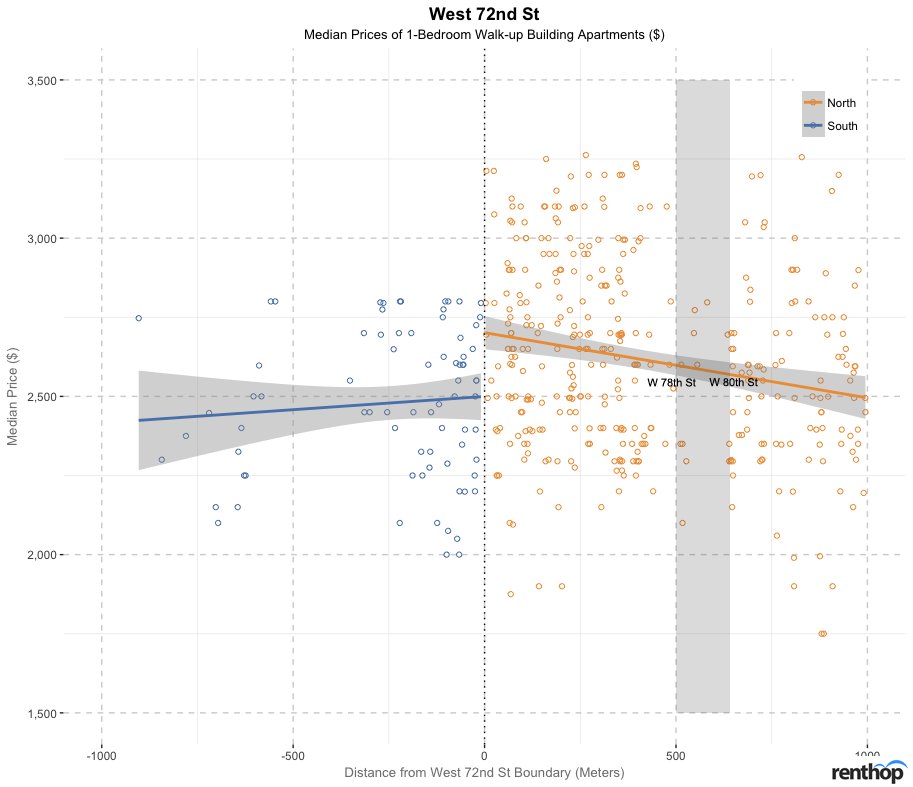
A close-up investigation of the walk-up building apartments reveals that walk-up building apartments are sparser between 500 m and 640 m to the north of W 72nd St (to be exact, the region spans from W 78th St to W 80th St), with median prices falling below $3,000. This region juxtaposes the American Museum of Natural History, which lies to its right, and explains why the area consists of mostly more expensive non-walkup building apartments instead.
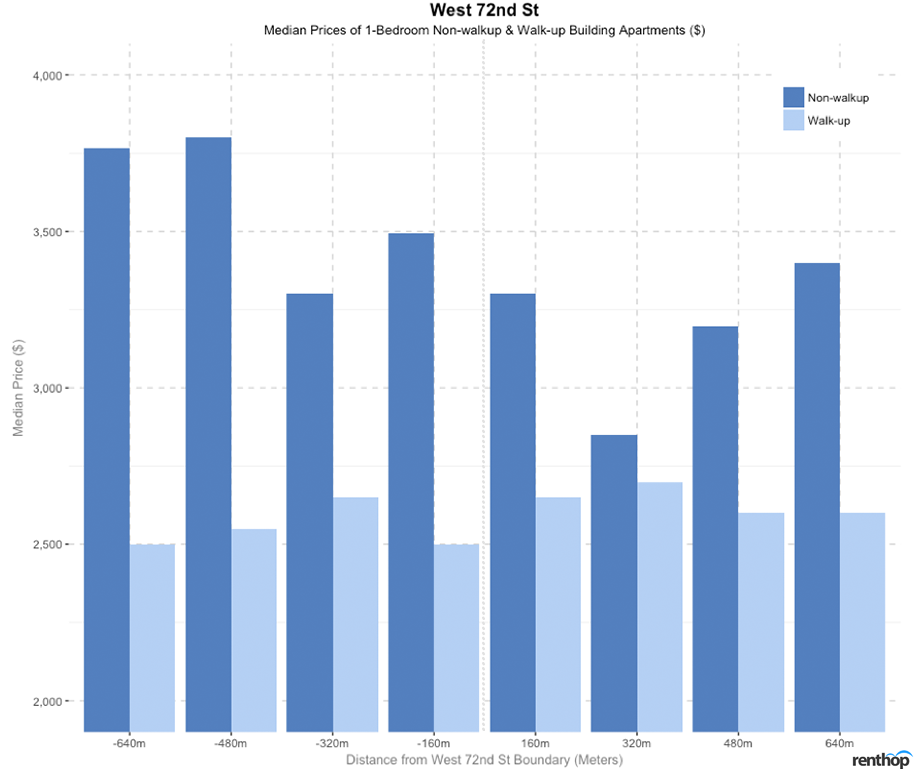
Non-walkup building apartments are generally more affordable north of W 72nd St and walk-up building apartments generally more affordable south of W 72nd St. There is also a price saving of $195 (from $3,495 to $3,300) for non-walkup building apartments 160 m north of W 72nd St. Prices of non-walkup building apartments continue to drop till 320 m before increasing again.
Price savings across E 73rd St: No significant price savings but prices of apartments south of the street are generally more expensive.
Neighborhoods: Upper East Side (North), Lenox Hill (South)
The trend of rental prices across E 73rd St is similar to that of W 72nd St, where renting a 1-bedroom apartment north of E 73rd St is relatively more affordable as compared to renting an apartment south of E 73rd St in Lenox Hill. A continuous decrease in median rental price is observed from the trend lines on the plot moving from south to north of E 73rd St.
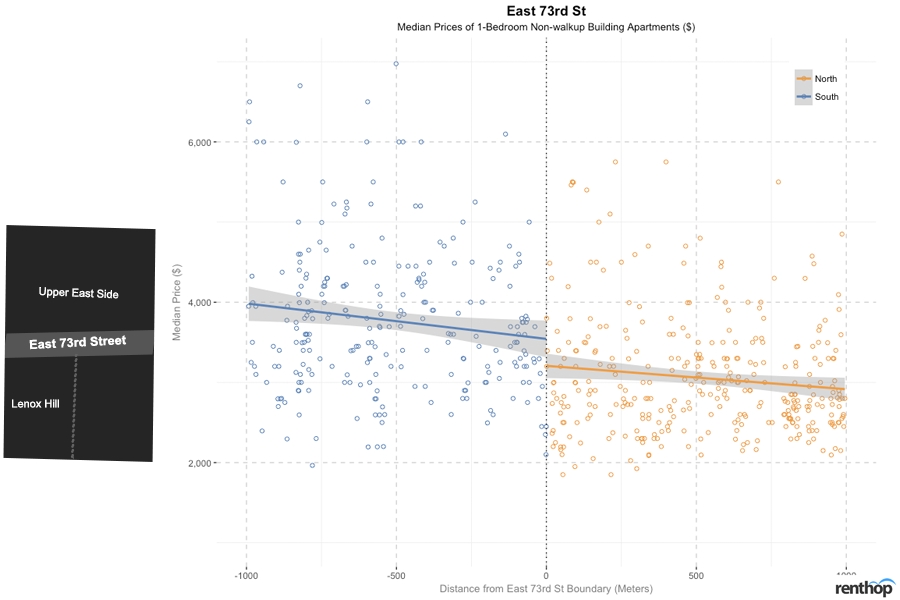
As we take into account of the percentile difference across the street, across non-walkup building apartments, moving south of E 73rd St to the Lenox Hill neighborhood would cost you 17.2% to 19.6% more than north of E 73rd St. Across the walk-up apartments, there is less variation in prices. Moving south of E 73rd St to the Lenox Hill neighborhood would cost you 2.1% to 4.0% more than north of E 73rd St.
Despite being in the vicinity of UES, why is it more expensive to live in Lenox Hill than UES? As mentioned earlier, with the opening of the 2nd Avenue subway station with the Q line in 2017, it has become more accessible and convenient to get to the UES region and crowded subway stations around the other stations are no longer as much of a problem as it used to be. Furthermore, more destination buildings including new condo buildings, upscale, prime buildings with higher prices and a wider range of amenities have been built in Lenox Hill in the more recent years, adding more value to its apartment prices and jacking up the rental price within the region.
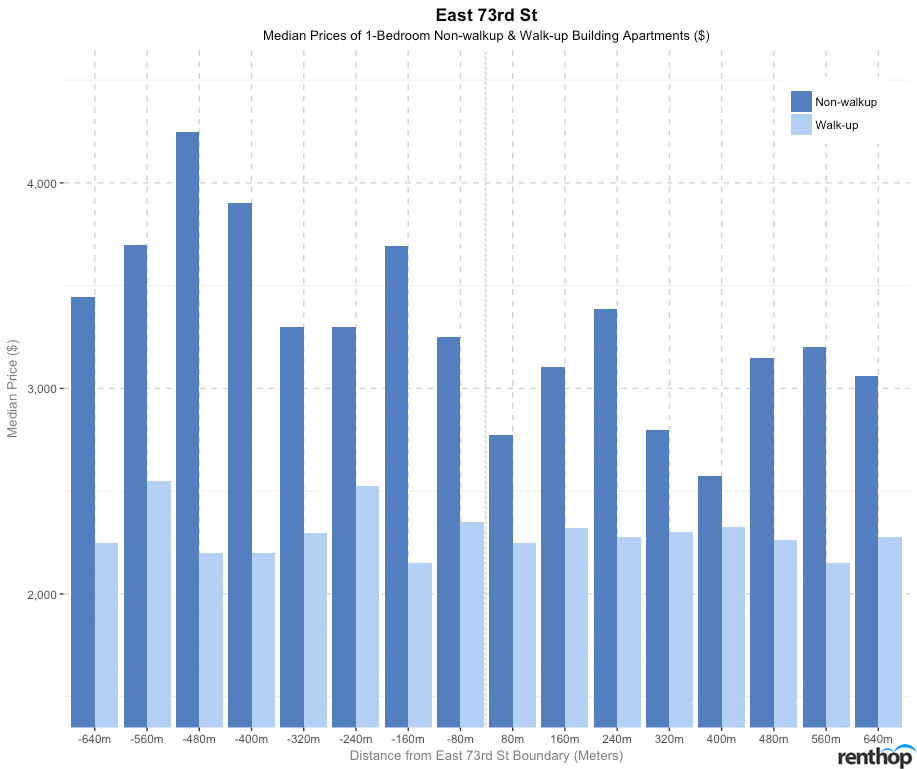
We also note that there are no significant price savings across E 73rd St from both directions. However, we can confirm that the median prices of non-walkup building apartments south of E 73rd St generally experience a steady increase as we move further south from the street boundary, whereas the median prices of non-walkup building apartments generally experience a steady decline from 240 m north of E 73rd St.
Price savings across W 125th St: Inconclusive due to sparse data points. However, apartments south of W 125th St command a higher price as an effect of being located in the vicinity of a college town.
Neighborhoods: Manhattanville (North), Morningside Heights (South)
Apartments south of W 125th St are generally much more expensive than apartments north of W 125th St, including non-walkup building and walk-up building apartments. Our data reveal that the jump in prices of building apartments ranges from 29.4%-34.6% whereas the price differences of walk-up building apartments ranges between 23.1%-27.6% across W 125th St to the south.
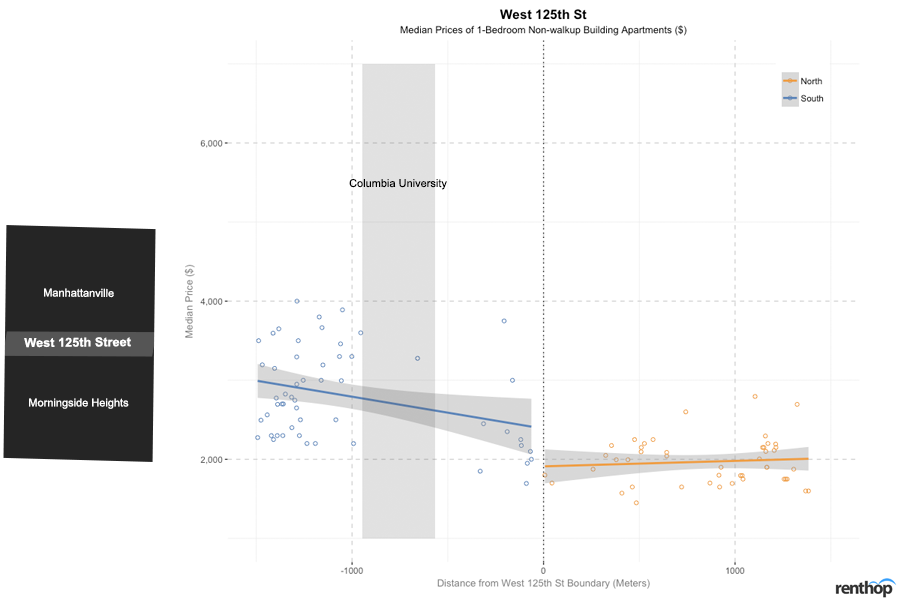
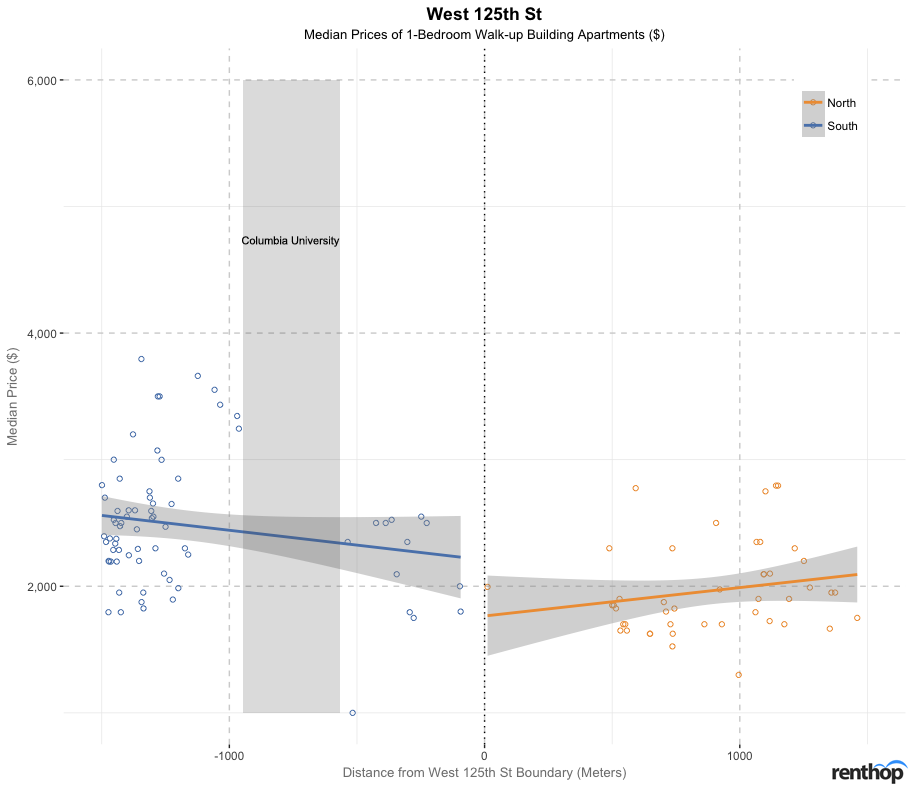
However, we take into account that the data points used in our analysis of W 125th St were sparse to fully draw a definite conclusion about the exact price savings across W 125th St. With Morningside Heights (south of W 125th St) known to be a prominent college town, home to Columbia University (highlighted in grey), Barnard College and several smaller schools, the apartments in Morningside Heights commands a price premium associated with high-quality schools in the vicinity.
Price savings across E 14th St: A price saving of about $205 per block north of E 14th St for non-walkup building apartments and a price saving of about $240 per block south of E 14th St for walk-up building apartments. Thereafter, prices fluctuate in both north and south directions.
Neighborhoods: Gramercy Park, Stuyvesant Peter Cooper Village (North), East Village, Alphabet City (South)
14th St is no doubt a major crosstown and shopping location in the heart of Manhattan. We first investigated if there were any trends observed across 14th St and found out that while no general patterns are observed north and south of 14th St and W 14th St, there is a contrasting difference in pricing behavior between non-walkup and walk-up building apartments across E 14th St.
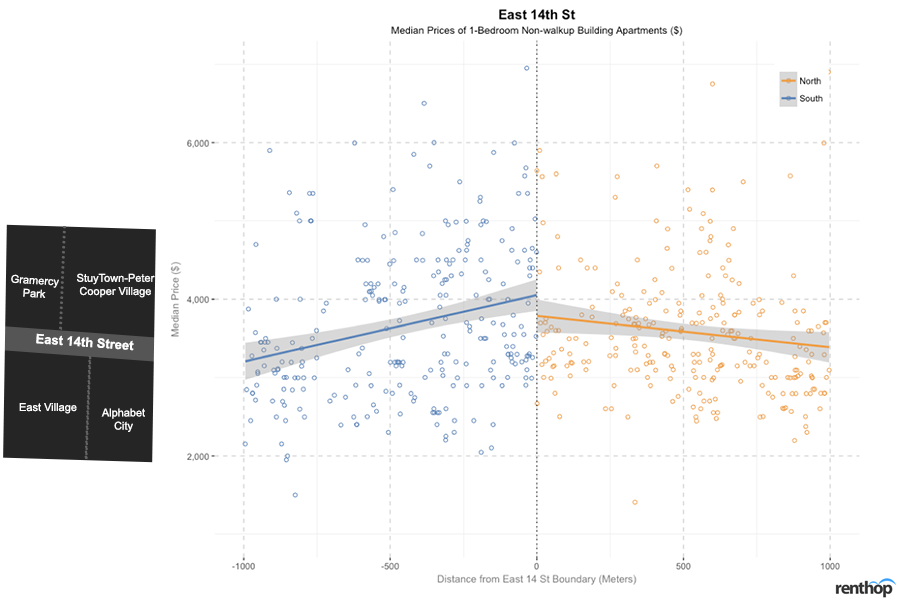
 The median prices of non-walkup building apartments south of E 14th St are more expensive than those on its north, but the presence of walk-up building apartments, on the contrary, are denser and more expensive north of E 14th St by about 6.2% to 10.9%, which contributes to the overall higher rental prices across all apartment types north of E 14th St.
The median prices of non-walkup building apartments south of E 14th St are more expensive than those on its north, but the presence of walk-up building apartments, on the contrary, are denser and more expensive north of E 14th St by about 6.2% to 10.9%, which contributes to the overall higher rental prices across all apartment types north of E 14th St.
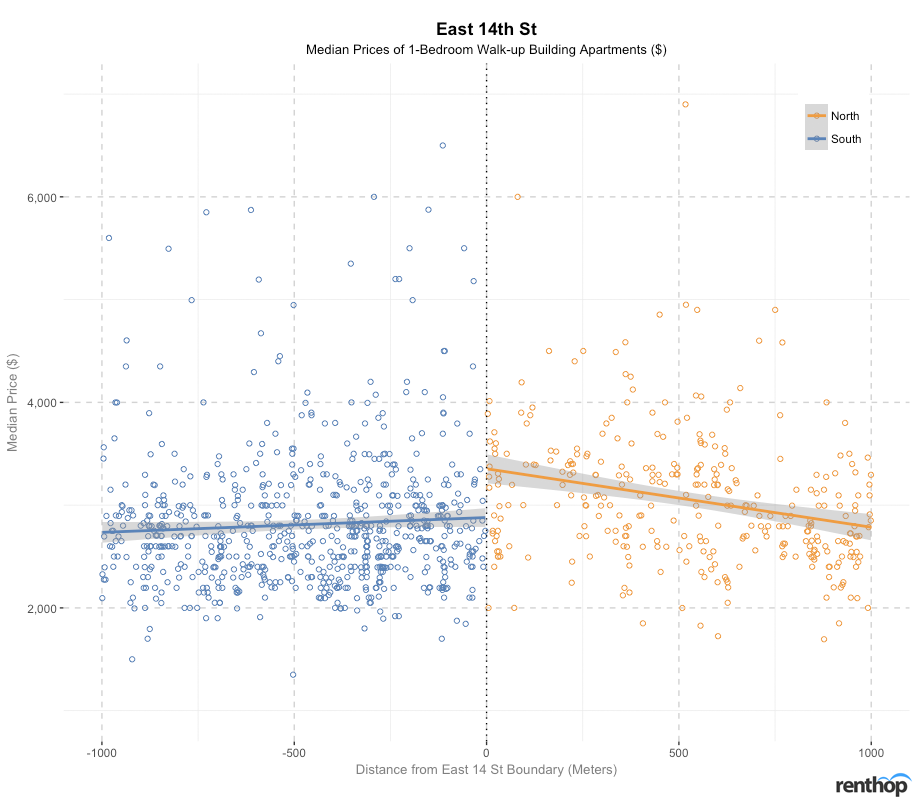
A contrasting pricing trend between the different apartment types across E 14th St leads us to believe that market forces are at play here. The effects of the rental price patterns can be traced back to the purchase deal of Stuy Town for $5.3 billion by Blackstone and Ivanhoe Cambridge back in 2015. As part of a binding agreement with the city, these firms have agreed to keep about 5,000 units of non-walkup building apartments affordable till 2035 for middle to low-income families. We believe this may be the reason why the median prices of non-walkup building apartments north of E 14th St, especially in the Stuy Town area, are more affordable than south of the street boundary.
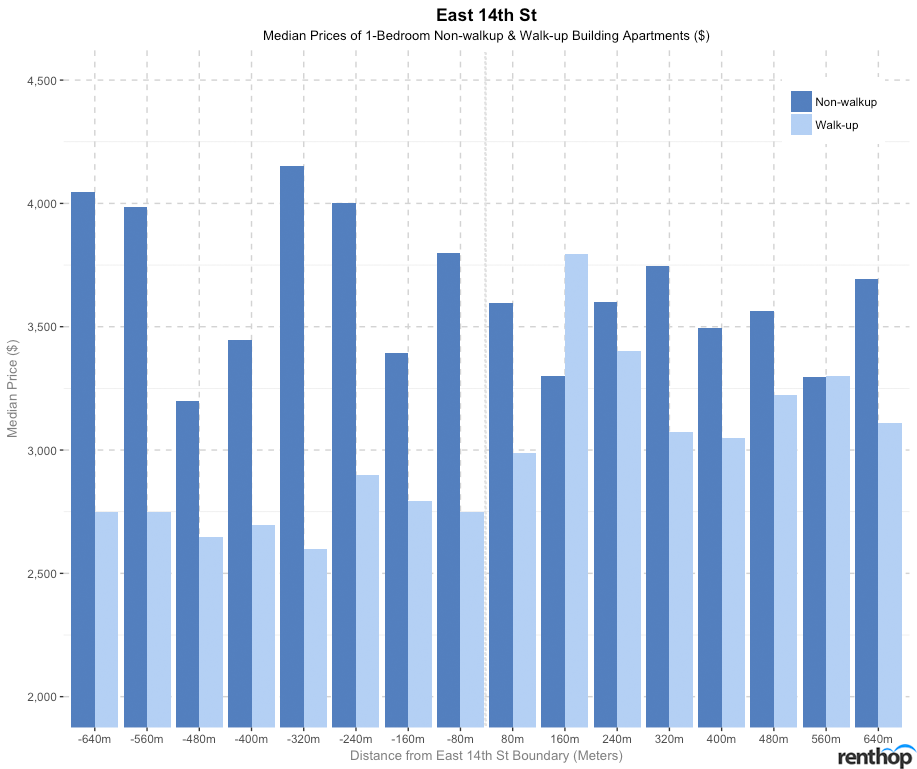
Across E 14th St, we notice a price saving of about $205 per block (from $3,800 to $3,595) north of E 14th St for non-walkup building apartments and a price saving of about $240 per block (from $2,990 to $2,750) south of E 14th St for walk-up building apartments. Thereafter, median prices of non-walkup and walk-up building apartments fluctuate. Generally speaking, non-walkup building apartments are more affordable on the north of E 14th St while walk-up apartments are more affordable on the south of E 14th St.
Price savings across Houston St: A significant price saving of about $477.50 per block and $200 per block for non-walkup and walk-up building apartments 1 block north of Houston St respectively. Non-walkup building apartments are also found to be more affordable north of Houston St.
Neighborhoods: West Village, Greenwich Village, NoHo, Bowery, East Village, Alphabet City (North), Hudson Square, SoHo, NoLita, Lower East Side (South)
As a center of action in downtown Manhattan, Houston Street spans across the full width of Manhattan. A cursory glance at the data of Houston St would lead you into believing that apartments north of Houston St are generally more expensive than the ones south, with about 1.5%-5.5% difference in prices across the boundary. This is not exactly the case.
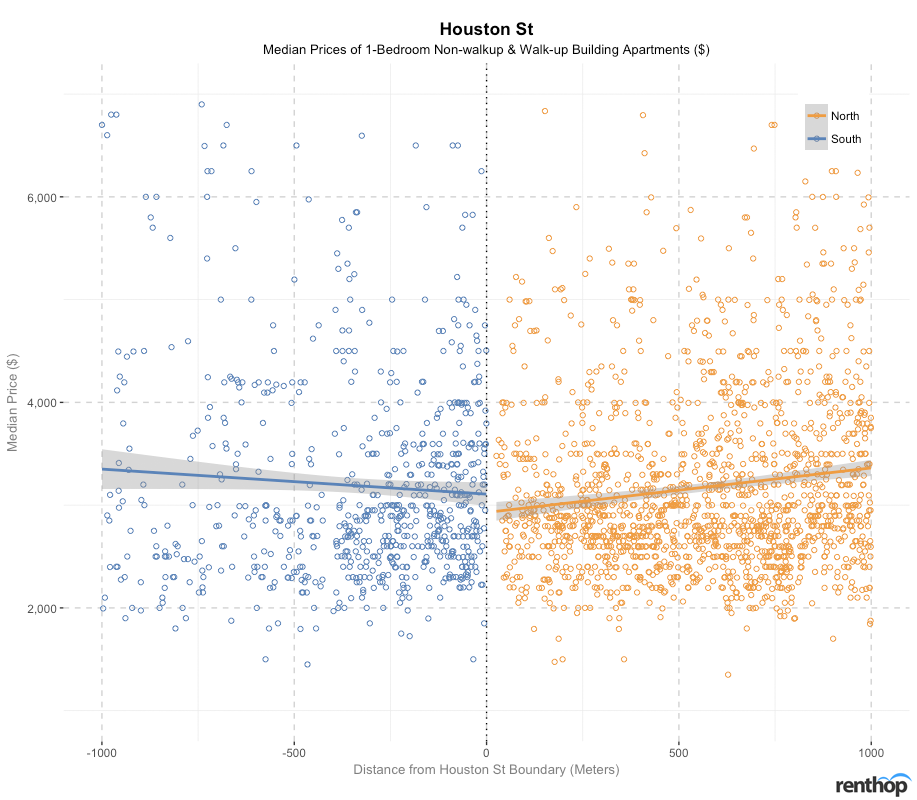
After taking a closer look at each of the apartment types, we noticed that Houston St shares a similar trend with Stuy Town with regards to non-walkup building apartments, where apartments north of Houston St are more affordable than apartments south of Houston St. We also noticed that non-walkup building apartments become sparser between the distance of about 250 m and 625 m north of Houston St, which coincides with the location of New York University and Washington Square Park.
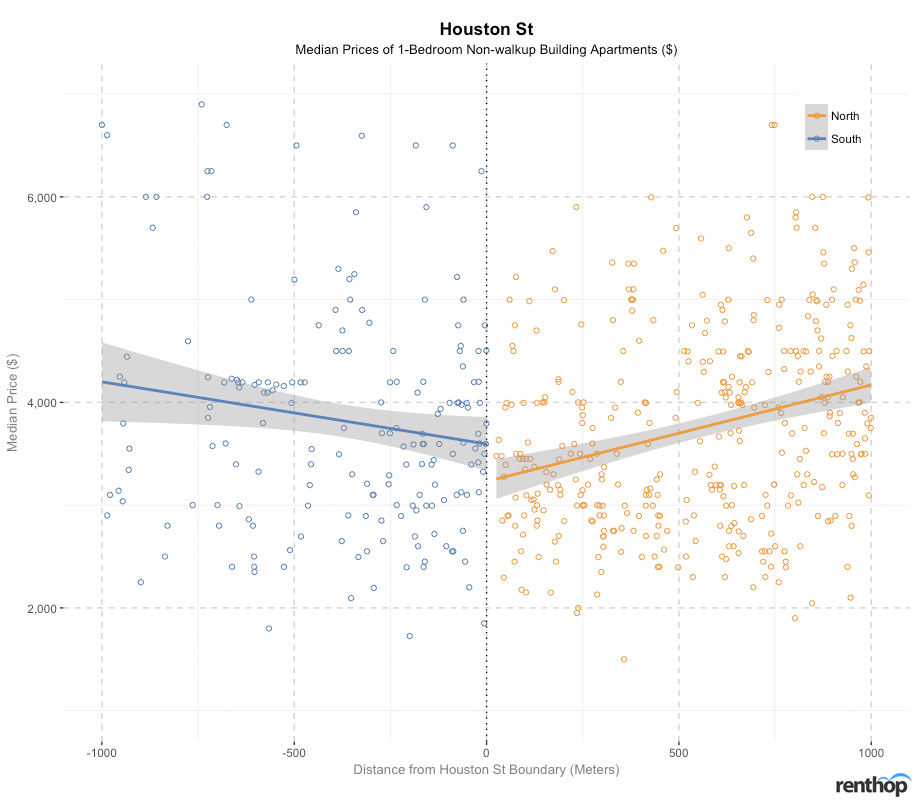
On the contrary, walk-up building apartments south of Houston St generally have lower median prices than north of Houston St, with the difference ranging from a small margin of 1.9%-6.8%.
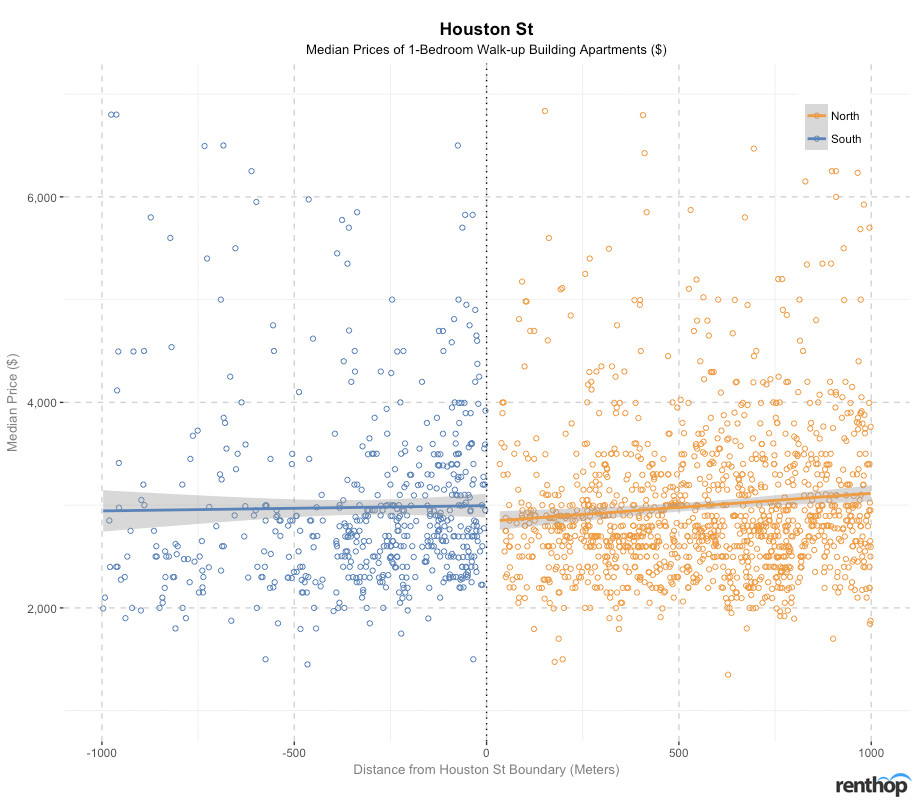
As walk-up building apartments are more common than building apartments in these few neighborhoods (namely, West Village, Greenwich Village, NoHo, Bowery, East Village, Alphabet City, Hudson Square, SoHo, NoLita and Lower East Side), the overall trend in rental prices is more heavily influenced by the pricing trend of walk-up building apartments. For non-walkup building apartments, there is a difference of 16.1%-19.0% across Houston St. There is also a larger number of apartments north of Houston St than south of the street. The sparse presence of apartments south of Houston St could be traced to being within the vicinity of SoHo in Lower Manhattan, where the neighborhood is more of a shopping destination.

Around the Houston St boundary, we see a price saving of about $477.50 (from $3,977.50 to $3,500) for non-walkup building apartments. Moving further north of the street, median prices of non-walkup building apartments decline gradually to 320 m before fluctuations set in. However, moving south of Houston St, median prices of walk-up building apartments experience a gentle decline to 480 m.
Price savings across Lower 3rd Avenue: Moving east, there is a major price saving of $995 per block for non-walkup building apartments and $50 per block for walk-up building apartments. A gradual decline in prices of apartments is also observed from west to east of the boundary.
Neighborhoods: Greenwich Village, NoHo, NoLita, Little Italy (West), East Village, Bowery (East)
An overview of all apartments across Lower 3rd Avenue indicates that apartments to the west of Lower 3rd Avenue are more expensive than the apartments to its east.
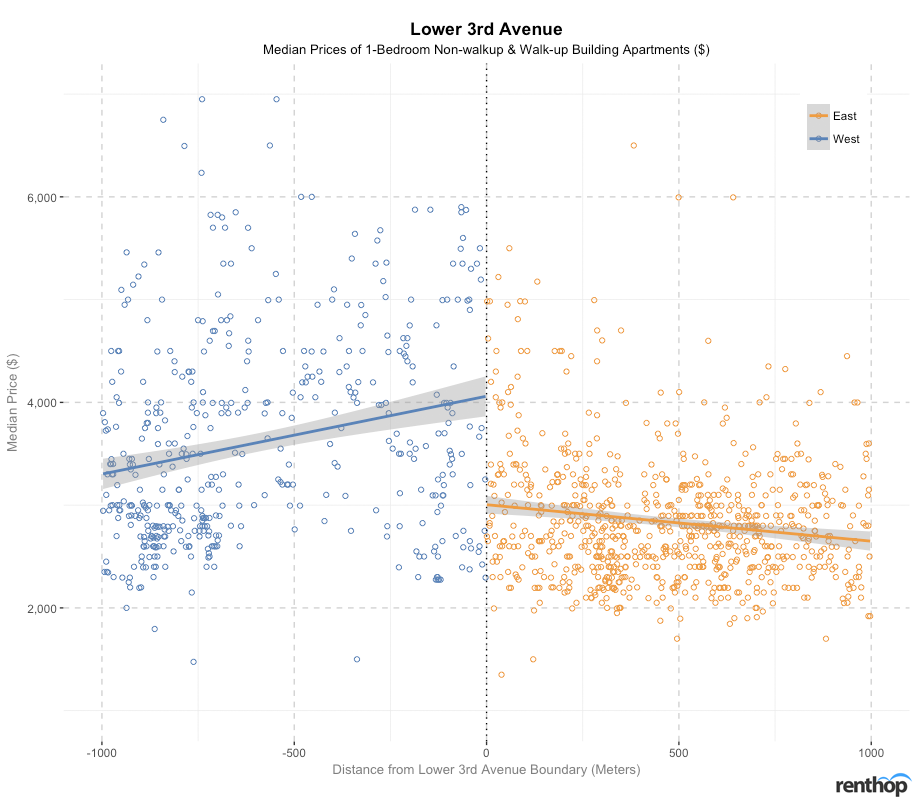
For non-walkup building apartments, 1-bedroom apartment prices generally increase towards the Lower 3rd Avenue boundary from east and west side of the boundary. Across Lower 3rd Avenue, the difference ranges between 22.5%-27.1%. A steeper increase in price is also observed from the east side of the boundary. To the east of Lower 3rd Avenue (Alphabet City), we also observe that non-walkup building apartments are sparser as compared the contiguous neighborhood to its west, where East Village is located.
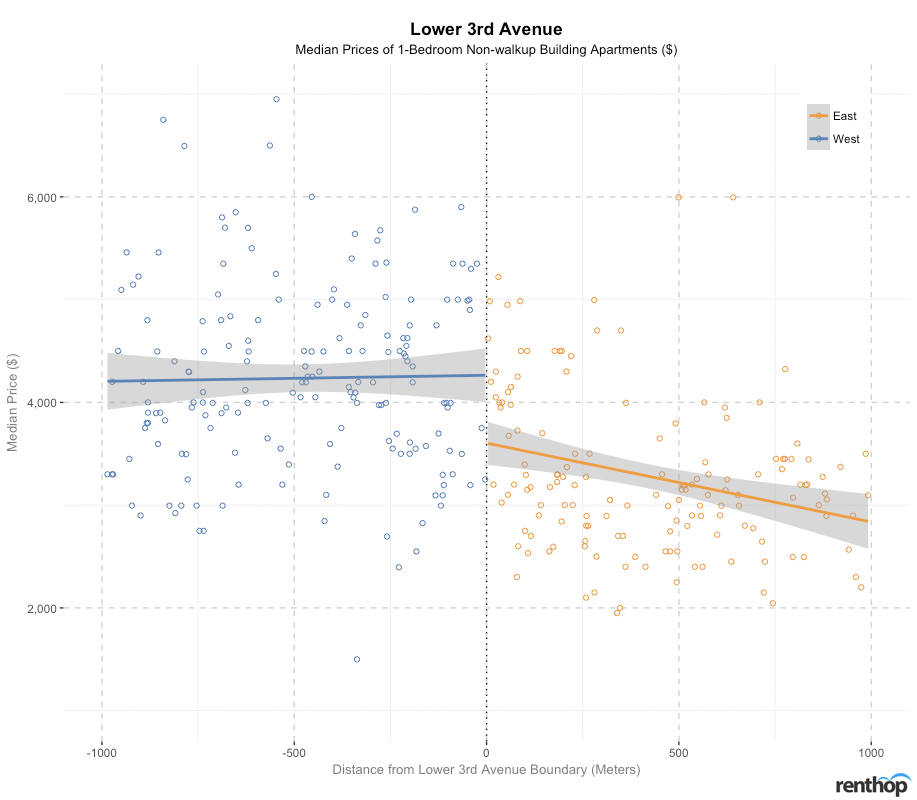
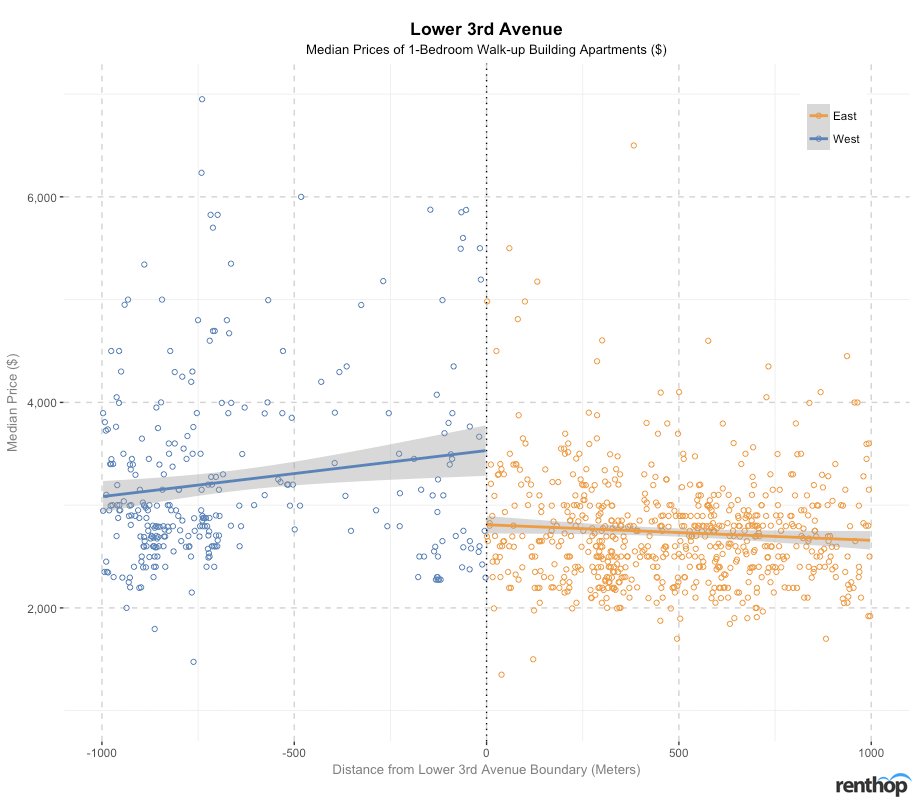
While 1-bedroom walk-up building apartment prices on the west side of Lower 3rd Avenue increases towards the boundary as well, the apartment prices to the east of Lower 3rd Avenue do not experience as steep of an increase in prices as non-walkup building apartments.
We also notice a gap in the number of walk-up building apartments to the west of Lower 3rd Avenue, particularly in the region between 300 m and 800 m, which coincides with the location where New York University and Washington Square Park is located.
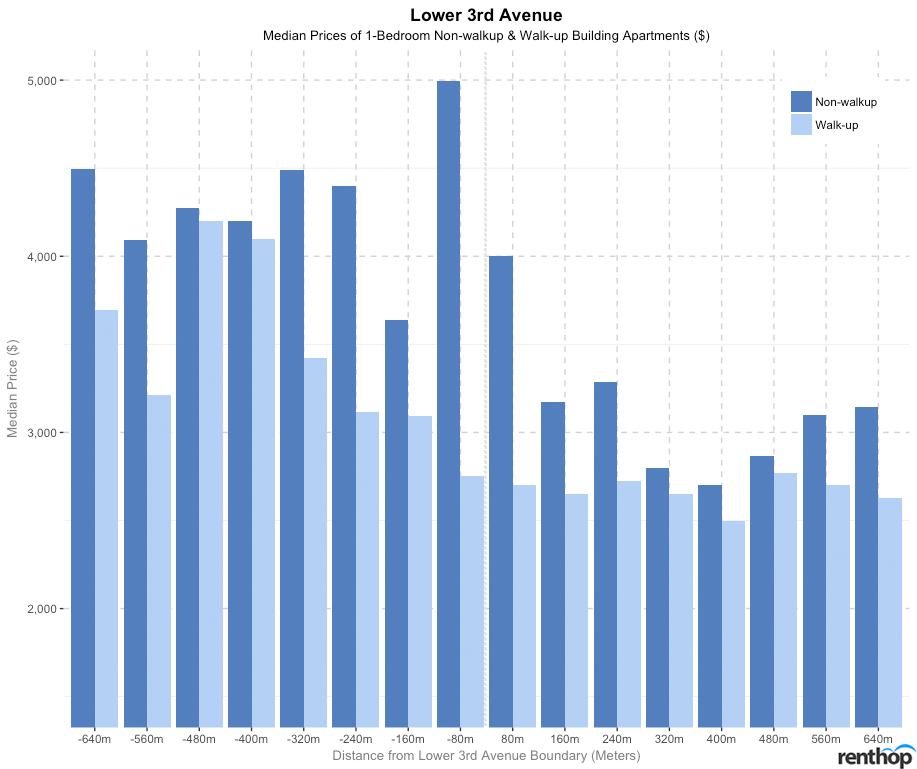
We can also confirm that the median prices of both non-walkup and walk-up building apartments decline from the west to the east of Lower 3rd Avenue, with a major price saving of $995 (from $4,995 to $4,000) for non-walkup buildings and a price saving of $50 (from $2,750 to $2,700) for walk-up buildings.
The table below summarises the differences in median prices across different streets based on percentiles for the 2 categories of apartments.

We will now move on to investigate the effects of median 1-bedroom walk-up building apartment prices across different streets and avenue boundaries in Brooklyn and Queens.
Brooklyn
Price savings across Metropolitan Avenue: No significant price savings across Metropolitan Avenue. There is only a very slight variation in prices between Williamsburg and East Williamsburg.
Neighborhoods: Williamsburg (North), East Williamsburg (South)
Median prices of walk-up building apartments decrease from the south-east to north-west of Metropolitan Avenue. However, if we zoom into the pricing behavior at the boundary, median prices of these apartments are slightly higher on the north-west of Metropolitan Avenue.
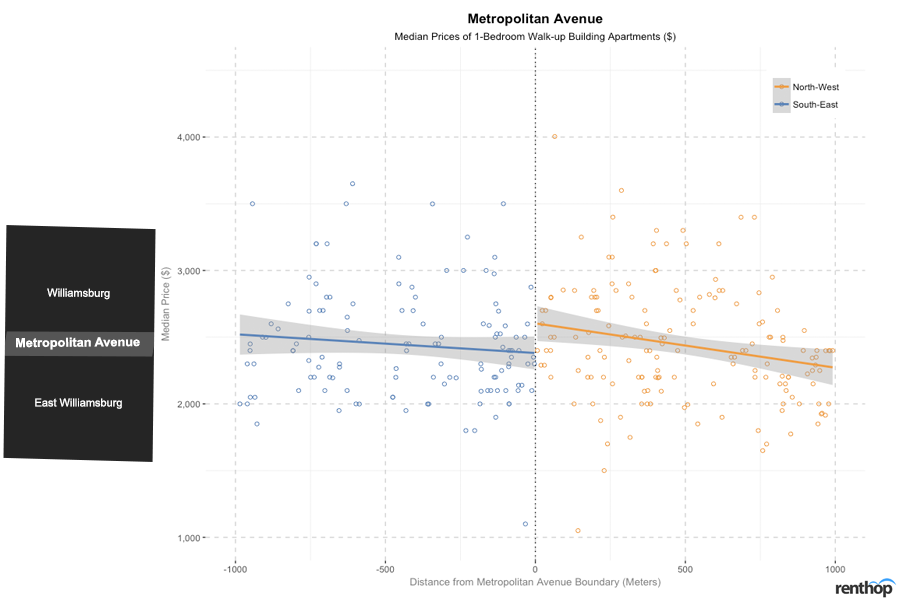
Since the 1980s, Williamsburg has been one of Brooklyn’s gentrification capitals. Being within the vicinity of Williamsburg, East Williamsburg is almost like an extension of Williamsburg. As a neighborhood on its own, East Williamsburg is turning into an up-and-coming neighborhood. Like Williamsburg, East Williamsburg offers a variety of hipster and trendy spots for leisure and dining.
However, compared to Williamsburg, East Williamsburg is less industrial and more residential, and offers a more affordable pricing option, by about 20.0%-31.4%.
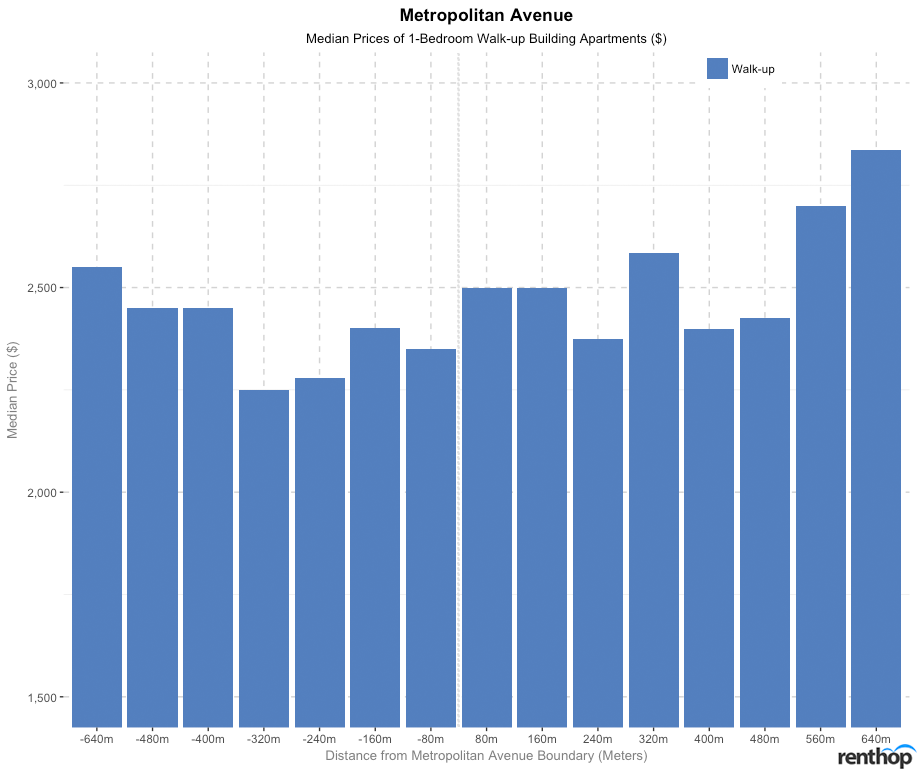
With a more detailed investigation of how prices differ from each individual block away from Metropolitan Avenue, we noticed that median prices of walk-up building apartments increase only very slightly from south to north, with negligible variation in prices overall, further confirming the fact that East Williamsburg is fast becoming an extension of Williamsburg.
Price savings across Classon Avenue: No significant price savings across Classon Avenue but median prices of walk-up building apartments to the west of the boundary are more expensive.
Neighborhoods: Clinton Hill, Prospect Heights, Prospect Park (West), Bedford-Stuyvesant, Crown Heights, Prospect Lefferts (East)
Median prices of 1-bedroom walk-up building apartments are more expensive on the west of Classon Avenue than to its east, with prices increasing towards the Classon Avenue boundary from the west and decreasing after Classon Avenue boundary to its east.
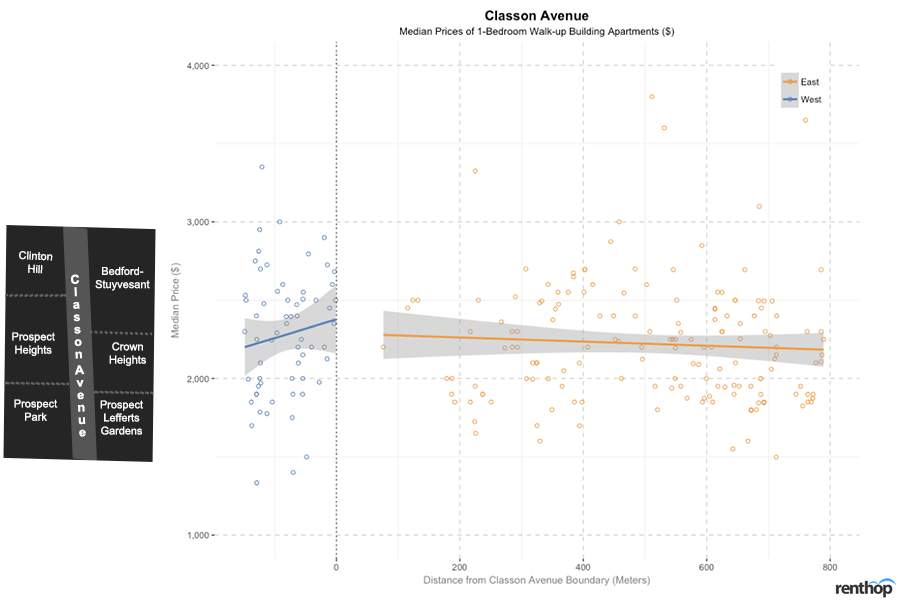
Neighborhoods including Bedford-Stuyvesant, Crown Heights and Prospect Lefferts, found on the east side of Classon Avenue have seen gentrification efforts in the recent years, with these neighborhoods coming up with new cafes, restaurants, bakeries, boutiques, galleries and wine bars, along with beautiful yet inexpensive brownstones. At the same time, new buildings and condos have also developed in the Prospect Heights region, which contributed to the rise in median prices in the area.
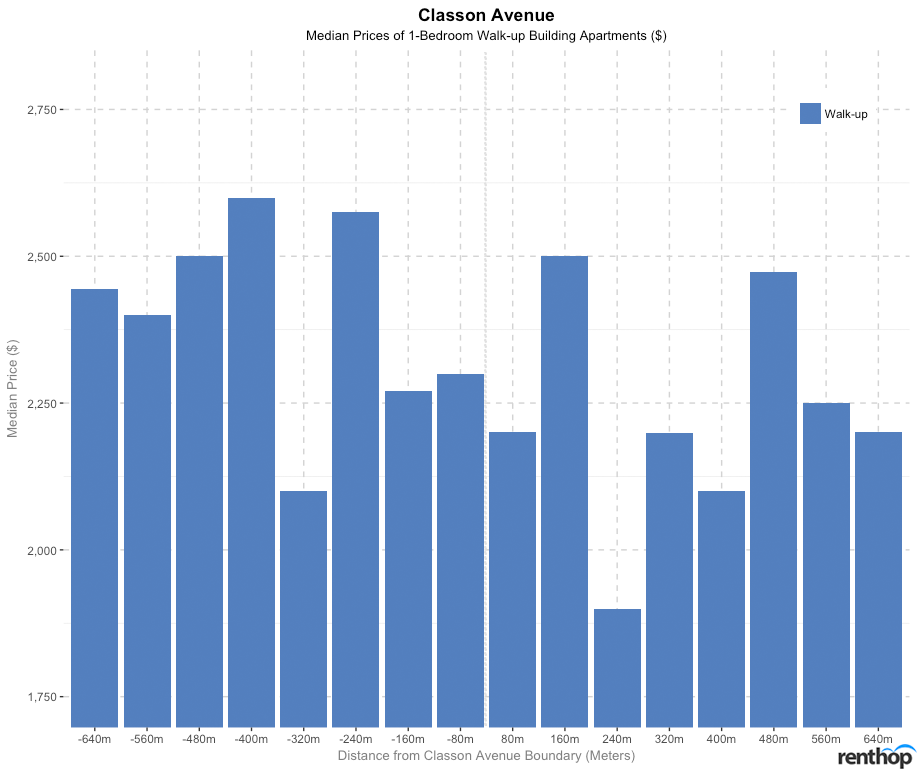
While there is not much variation in prices around the Classon Avenue boundary, walk-up apartments on the far west of Classon Avenue does indeed have higher median prices as compared to the east of Classon Avenue.
Price savings across Broadway: No significant price savings across Broadway, with both Bedford-Stuyvesant and Bushwick stepping up their gentrification efforts. However, a significant difference of $300 (from $2,150 to $1,850) is observed at 240 m (3 blocks) west of Broadway.
Neighborhoods: Bedford-Stuyvesant (West), Bushwick (East)
The general prices on both directions of Broadway differ only by a small margin of about 1.3%-4.3%, with walk-up building apartment prices increasing from the west to east side of the boundary.
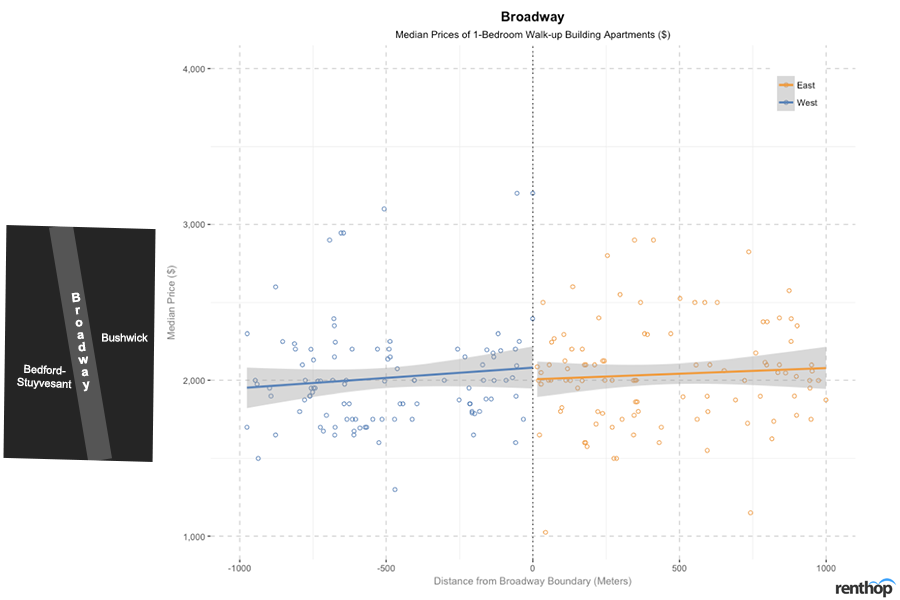
The two neighborhoods separated by this boundary have gone through similar changes. Gentrification of both Bed-Stuy and Bushwick began in the early 2000s. However, in the recent years, Bushwick has become a more popular neighborhood and well-known for its hipster art galleries, restaurants, and cafes.
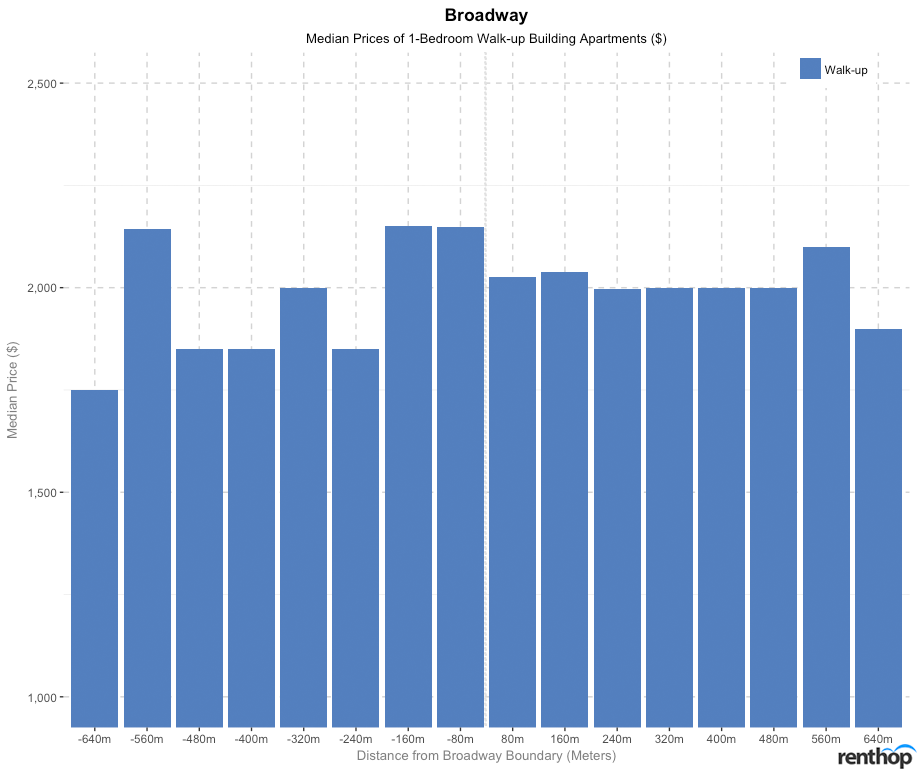
Generally, median prices of walk-up apartments are higher towards the east of Broadway than the west. A price saving of about $300 is also observed at 240 m (3 blocks) west of Broadway for walk-up apartments.
Price savings across Parkside Avenue: A price saving of $515 is found across Parkside Avenue 160 m to the north. Walk-up apartment buildings to the north are generally more expensive.
Neighborhoods: Windsor Terrace, Prospect Park, Prospect Lefferts (North), Kensington, Flatbush (South)
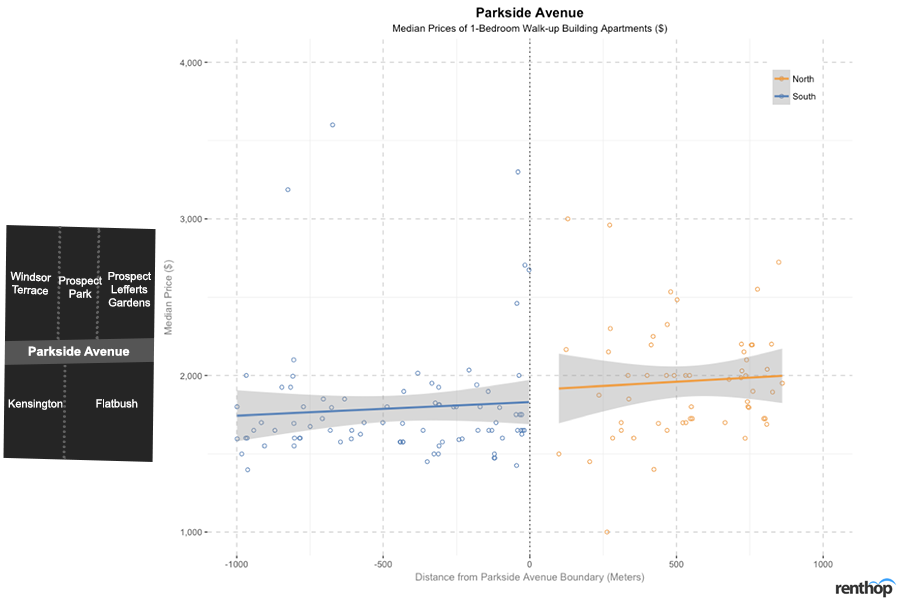
Median prices of walk-up building apartments north of Parkside Avenue are generally higher than those on the south side. However, the differences in median prices across the boundary are only about 3.0%-8.9%. The more affordable apartment options within the area are located in Windsor Terrace, Prospect Park, and Prospect Lefferts. Comparing neighborhoods across Parkside Avenue, Prospect Park to its north is the most expensive neighborhood, with a median price of $2,653. If you’re looking for even more affordable options, consider neighborhoods south of Parkside Avenue – Kensington and Flatbush.
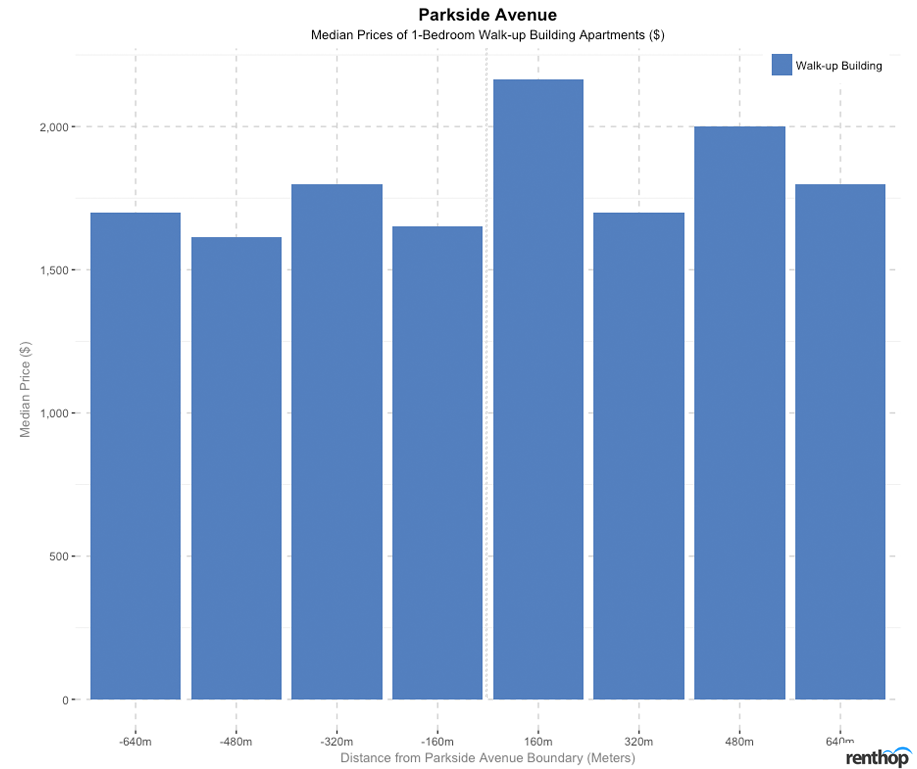
There is little variation in median prices of apartments, but we notice that at 160 m, median prices of walk-up building apartments increase by $515 at 160 m to the north of Parkside Avenue. However, because we are comparing all three neighborhoods, Windsor Terrace, Prospect Park, and Prospect Lefferts Gardens, at once, it is difficult to draw a conclusion as to whether the price difference applies to all apartments north of Parkside Avenue. We can only find out how the median price changes from Prospect Park towards its surrounding neighborhoods.
Queens
Price savings across 36th Avenue: No significant price savings across 36th Avenue, but there is a difference of about $250 (from $1,800 to $1,550) 320 m (roughly 4 blocks) south of 36th Avenue.
Neighborhoods: Astoria (North), Long Island City (South)
There are various distinctions between Astoria and Long Island City. Generally, we notice that prices of apartments south of 36th Avenue decreases towards the boundary but increases north of 36th Avenue.
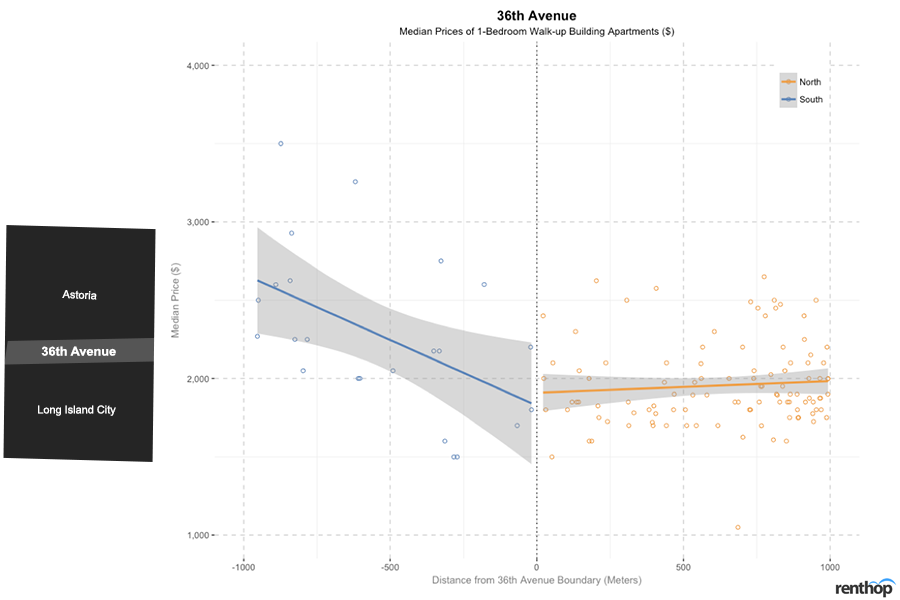
With affordability as a basis of comparison, Astoria is considerably more affordable than Long Island City, as there are more high-rises with views of the city across East River in Long Island as an effect of the rezoning of Long Island City in 2001. However, Astoria is also rapidly gentrifying in the recent years, which results in only a slight difference in prices.
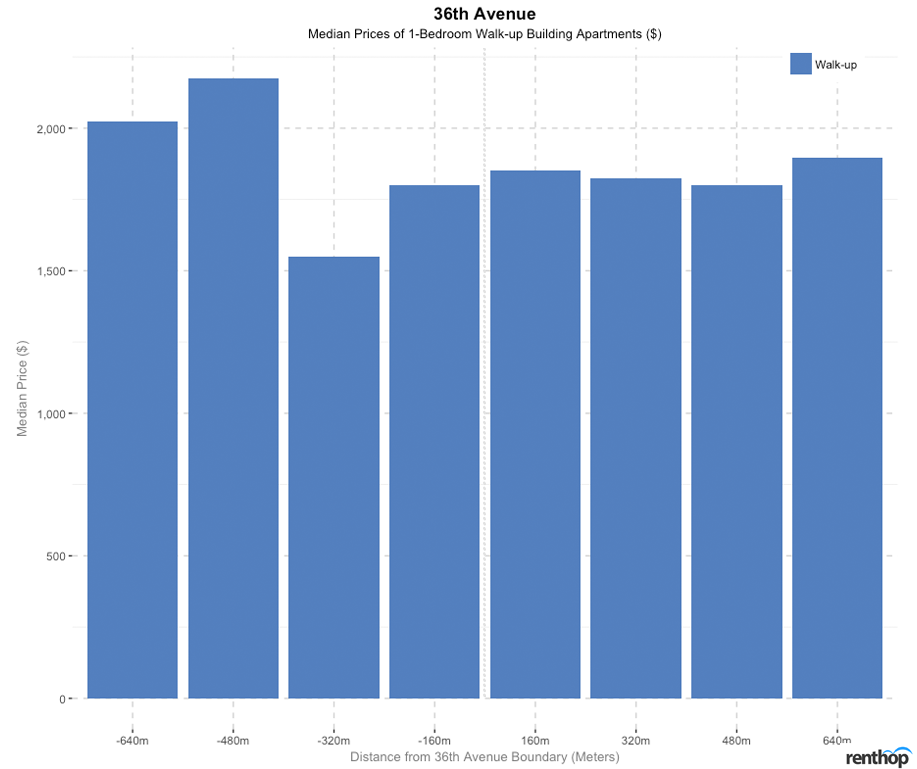
While there are no price savings observed around the 36th Avenue street boundary, however, we noticed an anomaly where the median price of walk-up apartments drops by about $250 from 160 m to 320 m south of 36th Avenue.
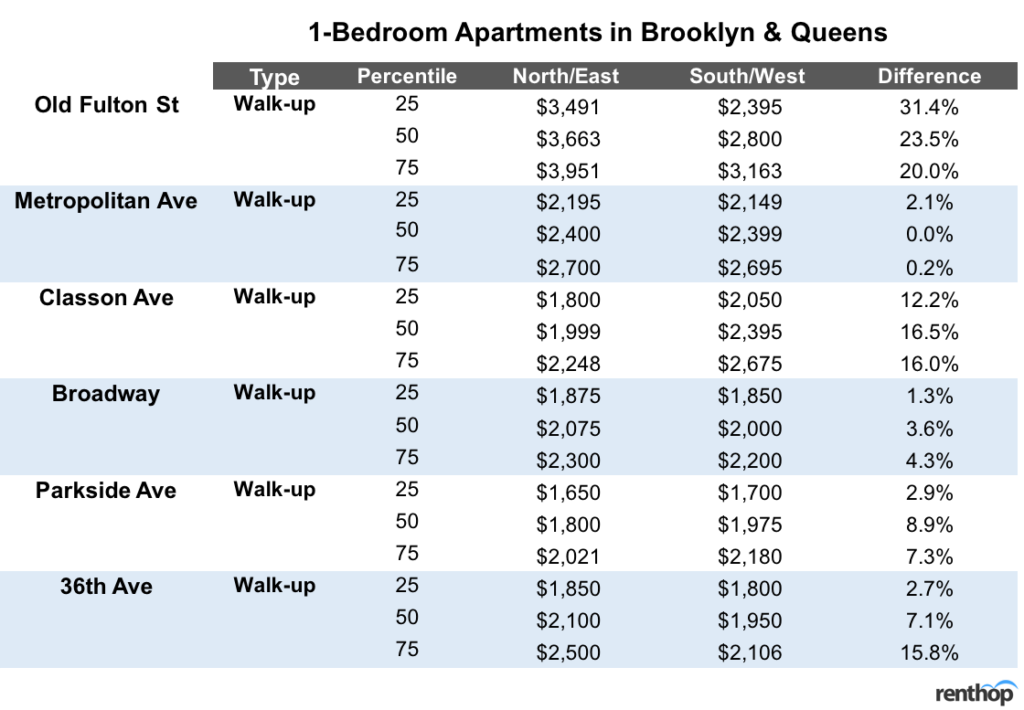
Conclusion
Our study has revealed that choosing to rent a 1-bedroom apartment across some street boundaries, such as East 96th Street, West 72nd Street, East 14th Street, Houston Street will provide renters with significant price savings. On the other hand, we have also discovered that the gentrification efforts in East Harlem have shifted the boundary slightly to the north by about 160 m and narrowed the gap of prices of 1-bedroom walk-up building apartments between Williamsburg and East Williamsburg across Metropolitan Avenue.
Methodology
The data used in this analysis is derived from RentHop’s listings from August 2017 to January 2018. Listings with the same address are de-duplicated into a single point as they suggest apartments are in the same building. *Note: As data points are sparse in some regions of the plots, the median prices are aggregated by 160 m intervals to provide a better picture of the pricing trends.




